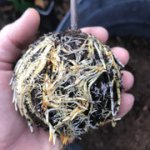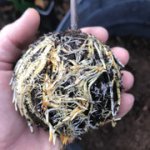I used to use those plastic balls, but went back to bags. I think most people fill each half of the ball with medium, then press them together around the branch. This means that when the ball is opened only the roots are holding the two hemispheres together, and I sometimes found that the medium stuck to the plastic. If the roots were strong this was no problem, but weaker roots could break. With bags, fibrous medium containing coir or peat could be wrapped around the branch in a single mass rather than having two halves pressed together, meaning that the rootball was more robust than with the plastic ball during the removal process, not to mention that the bag can be peeled off, whereas the ball has to be pulled apart.
Another aspect to consider is that the balls result in roots in a smoothly surfaced sphere, and I sometimes found that the roots were less inclined to turn outwards and penetrate the surrounding medium when the ball was transplanted. Bags produce a rougher surface : even here I usually prise off some of the medium with a sharp object (or even hose some of it off) to loosen the roots and make it easier for them to grow outwards after transplanting.




